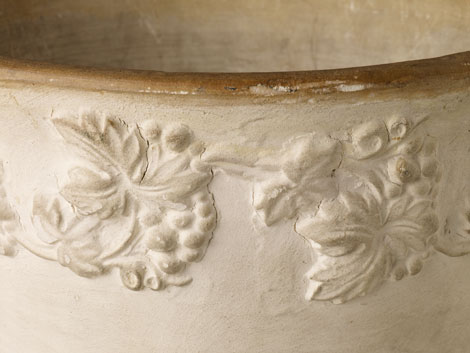Jardineires
Jardineires
c. 1900
James Price (1834–1912) / Port Arthur Pottery, maker
ceramic (earthenware, slip)
Purchased with the assistance of the Art Foundation of Tasmania, 2007
23.5 h x 21.5 w x 21.5 d cm
P2007.64 and P2007.65
Provenance
Purchased by the Tasmanian Museum and Art Gallery at auction in Hobart, Tasmania, 2007 with the assistance of the Art Foundation of Tasmania.
History
James Price (1834–1912) was born in the renowned pottery district of Staffordshire, England and migrated to Tasmania in 1884 at the age of fifty. In 1886 he purchased land at Carnarvon, the name that had been given to Port Arthur after the closure of the notorious penal establishment in 1877. The land had been a brickyard and, as part of the prison, would have been worked by transported convicts; it had a good supply of reasonable quality clay and was equipped with some pottery facilities. Price built a beehive kiln and gathered wood from the surrounding area to fire his range of utilitarian, domestic and decorative pottery. His utilitarian items included flowerpots, roof tiles and pipes; his domestic wares included plates and bowls, decorative flowerpots and planter boxes, jugs, jars and other items.
Although James Price probably made most of his income supplying utilitarian wares, such as the pipes he provided to the local municipal council, the growing tourist market may also have initially attracted him to the area. Towards the end of the nineteenth century Carnarvon was already well established as a tourist attraction and James Price capitalised on this by marking many of his wares, including these decorative flowerpots, ‘PORT ARTHUR’. He also made novelty and souvenir products. Price’s wares are somewhat crudely made and fired and it has been suggested that his original training in Staffordshire was as a brick or tile maker.

Description
Two earthenware flowerpots with cast relief decoration. The flowerpots are circular, with straight sides tapering towards a substantial integral domed base. The exterior has a slip-coated, sprigged decoration of roses to the lower part of the body and a continuous wreath of grape vines immediately below the rim. Throwing marks are clearly evident on both the exterior and interior.
Statement of Significance
The Tasmanian Museum and Art Gallery seeks to build a comprehensive representation of Tasmanian colonial decorative arts. This includes items made in Tasmania from 1803 through until 1901. James Price’s pottery at Port Arthur was typical of the small-scale artisanal production of ceramics in nineteenth-century Tasmania. Though roughly made, these jardineires exhibit some refinement of detail such as the use of a slip of finer clay over the coarser base material and the incorporation of moulded decoration.
Inscriptions
 P2007.64: Inscribed in pencil underneath the flowerpot: ‘from Point Peur’ (sic) with a series of illegible numbers crossed out (which may have been a price). Evidence of a rectangular paper label to the underside, and similar evidence of a circular label, since removed, to the outside face. Impressed into the outside face of foot within a rectangular stamp: ‘PORT ARTHUR’.
P2007.64: Inscribed in pencil underneath the flowerpot: ‘from Point Peur’ (sic) with a series of illegible numbers crossed out (which may have been a price). Evidence of a rectangular paper label to the underside, and similar evidence of a circular label, since removed, to the outside face. Impressed into the outside face of foot within a rectangular stamp: ‘PORT ARTHUR’.
P2007.65: Ghost of ‘79’ inscribed beneath glaze to outside of body. Paper label, round with serrated edge adhered to outside body possibly inscribed ‘72’. Impressed maker’s mark on the face of foot in a rectangular stamp: ‘PORT ARTHUR’.
References
Tassell, C 1983 (Introduction), Port Arthur Pottery, Queen Victoria Museum and Art Gallery, Launceston, Tasmania.
Ford, G 1995, Australian Pottery, The First 100 Years, Salt Glaze Press, Wodonga, Victoria, pp.173–5.

© 2009 Tasmanian Museum and Art Gallery
This page was last modified on :
1 July, 2010

